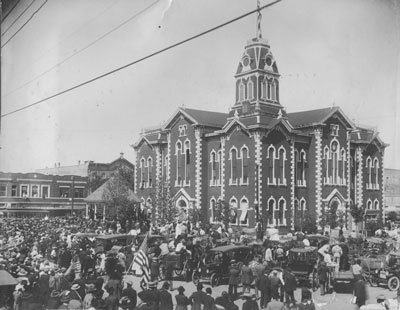
Hunt County Courthouse on San Jacinto Day 1917. A record-breaking crowd gathered to hear Texas Governor James E. Ferguson speak as the large U. S. flag was raised over the courthouse. Notice the over-whelming number of white males in the crowd.
April 1917 was an emotional time for the United States. Greenville and Hunt County were certainly included in the proud, patriotic, and frightening future.
On April 6, 1917, President Woodrow Wilson signed the Declaration of War against Germany and Austria-Hungary. We would soon join France, Great Britain, and their allies in the War to end all Wars. Thousand of men died in the previous three and one-half years earlier. Many American wondered how many more would perish?
Two days before Wilson signed the declaration, citizens of Greenville and Hunt County pooled funds to purchase an American flag twenty-five by fifteen feet and a seventy-foot flagpole to display the flag over the Hunt County Courthouse. Citizens of Commerce and East Texas State University followed suit with their flag to fly in the public square.
Fears raged that German spies were around every corner. One fairly substantial rumor spread the news some group plotted to blow up the cotton compress east of downtown Greenville. The sheriff, believing it true, sent guards to protect the property and other sites that were vulnerable.
African-Americans of Greenville held a rally on the courthouse square, pledging their support to President Wilson. They disclaimed any intention or disposition on their part to assist any foreign power. There was a growing sentiment for the organization of a Negro company in Greenville. Efforts were made to secure the proper authority for such action. A few days later new enlistments in the national defense organizations included Cornelius E. Hall, an Africa-American of Greenville.
At the same time, fifteen young men from Greenville enlisted in the U. S. Navy, leaving immediately for Dallas where they would be assigned for training. Over in Hopkins County, Greenville resident Willie J. Durham registered for the draft. Only a school boy at the time, Durham would become one of the leading African-American attorneys in the state of Texas and the United States when he was Witness for the Plaintiff in two monumental Civil Rights cases years later.
On San Jacinto Day, April 21, 1917, a crowd of an estimated 5,000 people gathered on the courthouse square to hear Governor James E. Ferguson deliver the principal address as the huge flag rose over the courthouse. San Jacinto Day had been a special event for years, but this was the largest gathering ever. Officials and citizens gave speeches supporting the President, his ideas, and all young men who had volunteered their service in military branches. Old Confederate soldiers marched around the courthouse, many in their old uniforms. A resolution pledging the support of all Hunt County citizens to President Wilson was adopted at the rally. The selective draft plan of raising an army was wholeheartedly favored.
Four days later a humorous event occurred in Commerce near the college campus. Mrs. John Wells stated that around 5:35 that morning she saw a flying machine not very high above ground traveling due north. She described the vehicle as shaped like a canoe with three passengers. As it flew over the campus it sped across the sky. As it was broad daylight, she was absolutely positive there was no mistake. Could she have seen the famed Red Baron of the German Army Air Corps cruising over Texas prairies or was there something in her morning coffee?
